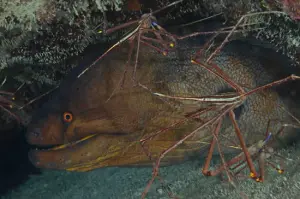I love all the different species of wrasse, and I thought I knew them well, but this one was a new one for me. I really enjoyed researching and learning all about this very pretty fish.
Meet the ‘Bird’ or ‘Birdmouth Wrasse’ (Gomphosus caeruleus). If you are lucky to go diving in the Red Sea, you are very likely to meet these fascinating fish in person. While the back end of this fish looks like a regular wrasse, its head and mouth are elongated, and it truly does look like a bird’s beak, hence the name. The beak helps them to fish out crustaceans, invertebrates and molluscs from narrow crevices in coral reefs where they live. They are even able to turn rocks over with their snout in search of their favourite foods. The beak is also lined with specialised sharp teeth which help them extract their food. With their feeding habits, they help to maintain a healthy ecosystem on reefs and recycle nutrients in the Red Sea by eating detritus and species that can otherwise take over the reefs if not kept in check.
They can reach up to 30cm in length, and males are colourful, vibrant greens and blues, whereas females are usually in shades of brown and green.
They are diurnal, coming to the surface during the day and resting near the seabed at night, sometimes as deep as 30m. If you are looking for them on a night dive, it is the deeper depths you need to go to find them. During the day, they visit cleaning stations where they are cleaned of parasites by cleaner fish and shrimp.
They have quite a long lifespan and can live for several years, from 5 to 10 years in the wild.
Like other species of wrasse, they are all females to start with and over time, some change to males, usually due to the lack of a dominant male in the area. This helps to keep the correct sex ratio in the local wrasse population and ensure reproductive success. It is not an easy process involving hormonal changes, and can take several weeks before it is complete. They exhibit complex social structures; while they are usually solitary during the breeding season, males can get quite territorial, and the dominant male maintains a harem of females.
They spawn in the early hours, and the males perform amazing courtship displays to attract females, including changing colours and speed of swimming, which makes for a lovely spectacle. Females release eggs and males sperm simultaneously by swimming upwards in the water column. The eggs are fertilised externally and drift with the current; even when they hatch, the larvae are planktonic, which helps promote genetic diversity by settling in different locations.
Their conservation status is currently quite healthy; however, due to habitat degradation, bleaching of coral reefs and overfishing, this might change in the very near future. They are also used in the aquarium trade, which might make them vulnerable, but they are not an easy fish to keep as they have special dietary requirements and are sensitive to water quality. Their natural predators – sharks and larger fish such as groupers, prey mainly on juveniles, but as the number of predators are also diminishing at a very fast rate, they don’t pose much of a threat to these pretty fish.
Several Marine Protected Areas have been established to help these pretty fish populations stay healthy and reproduce, so we can all admire them in their natural habitat.
Written by Bogna Griffin
Photos by Janez Kranjc
The post Pretty birds from the Red Sea appeared first on Mares – Scuba Diving Blog.
Read MoreDiving, birdwrasse, coral reef, Egypt, fish, marine life, red seaMares – Scuba Diving Blog




